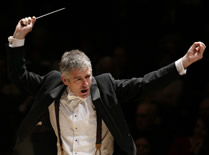Nelson Mandela (born 1918) was one of the great transformative figures of the twentieth century, bringing reconciliation and peaceful change to the Republic of South Africa, and richly deserves musical celebration. Gerald R. Knight and the Elon University Chorale commissioned a work in his honor from composer and pianist Karen Walwyn, who is professor of piano at Howard University, and was a visiting Mellon Faculty member at Duke University in 2011-2012. Included among Walwyn’s achievements are two CDs of contemporary music for piano by African-American composers including Baker, Hailstork, Singleton, the late Coleridge-Taylor Perkinson and others. More than a cantata, one might view the evening’s music as a mixed-media event, featuring both projected images of Mandela and South Africa, and a quartet of dancers.
The evening began with African drumming with percussionists Jim Roberts and Bradley Simmons, although the audience, alas, did not take this as a sign that the evening was beginning. Next, the eighty-voice chorale processed in, and the music began in earnest with an extended overture for solo piano, “Birth,” in which Walwyn demonstrated that she has both an impressive level of technique and an individual and expressive compositional voice, moving downward from first single and then double tremolos.
Following “Birth” there were three movements for chorus, originally intended to be unaccompanied (a cappella) but here discreetly supported by piano. Walwyn (and all contemporary composers) faced the challenge of creating a choral idiom that is not beyond the capabilities of young and amateur singers, and yet innovative, and here the added challenge of adding an African sensibility. “Madiba” included the male voices singing in fifths, as well as repetitive rhythms; “We are one” was chromatic and contrapuntal. The chorus was earnest and hard-working, but showed the normal characteristics for most if not all such college ensembles: the strongest section, both in terms of sound and technique, was the sopranos, followed by the altos; the men were considerably weaker, with the basses stronger than the tenors (assisted in places by the altos).
The first half (followed by a brief intermission) concluded with an extended musical representation for solo piano of the violent repression which took place in Soweto in 1976, with a composition that was similarly violent, disjunct, highly effective, and virtuoso.
The second half of the program began with an unaccompanied solo dance (in gumboots) by Jason Aryeh, and moved onto arrangements of South African songs which, closer to hymn-style, were more comfortably within the capabilities of the young singers. The evening closed with two movements marking the transition to Mandela’s presidency, with “It is three o’clock” making effective use of irregular rhythms for the choral diction.
Walwyn is a composer with promise, and with an increasing number of commissions. Her writing for piano is original, effective, and moving; her writing for chorus is not quite yet on that level. I look forward to her future work.











